The animal kingdom provides so much diversity that it’s almost impossible to keep track of all the different species in the world. Sometimes the distinction between close relatives is too hard to even notice. But different species often evolve in similar ways because of their environment.
We at Bright Side gathered 16 pairs of animals who are almost indistinguishable from each other at first sight in order to show you the differences between them.
1. Jaguar vs leopard
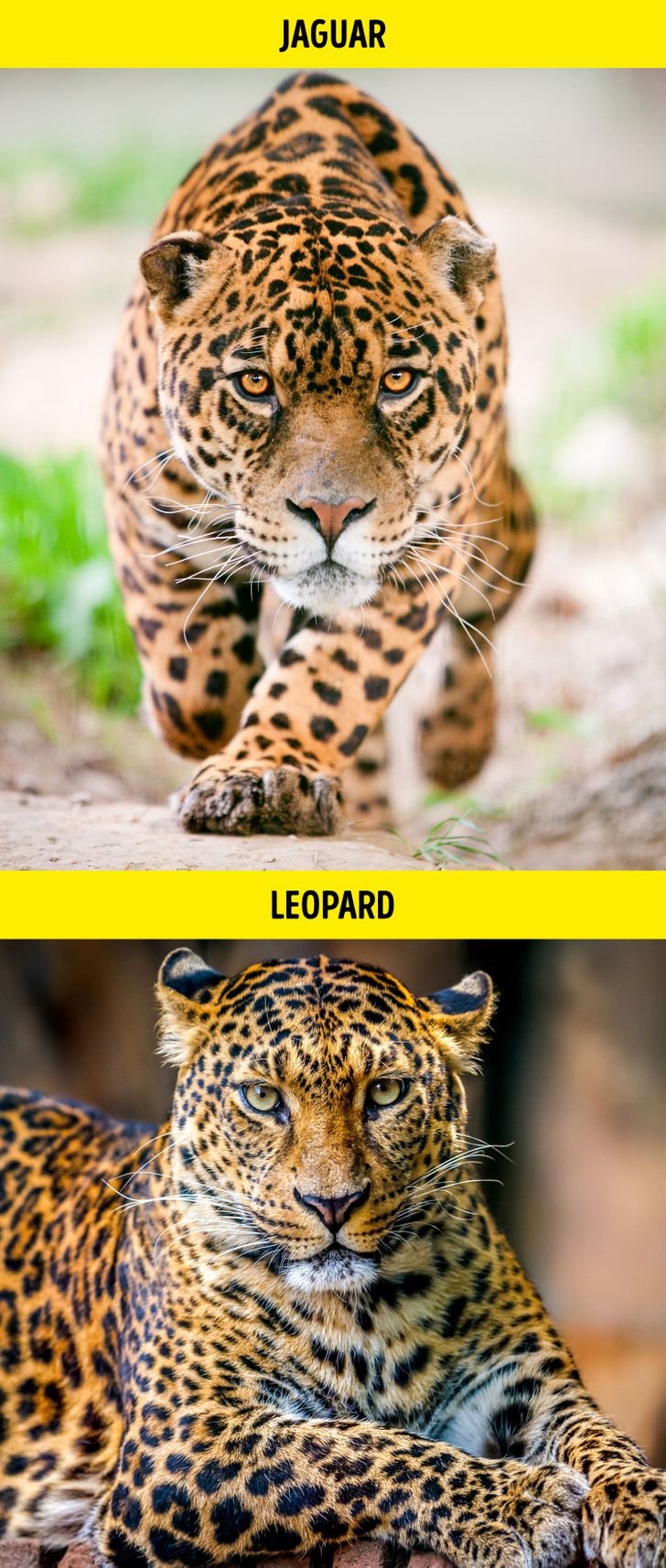
Despite their similarities, these big cats inhabit different continents and climate zones: leopards live in African savannas, while jaguars dwell in South American tropical forests. Jaguars are also larger and bulkier, and unlike leopards and many other cats, they’re fond of water.
2. Alligator vs crocodile
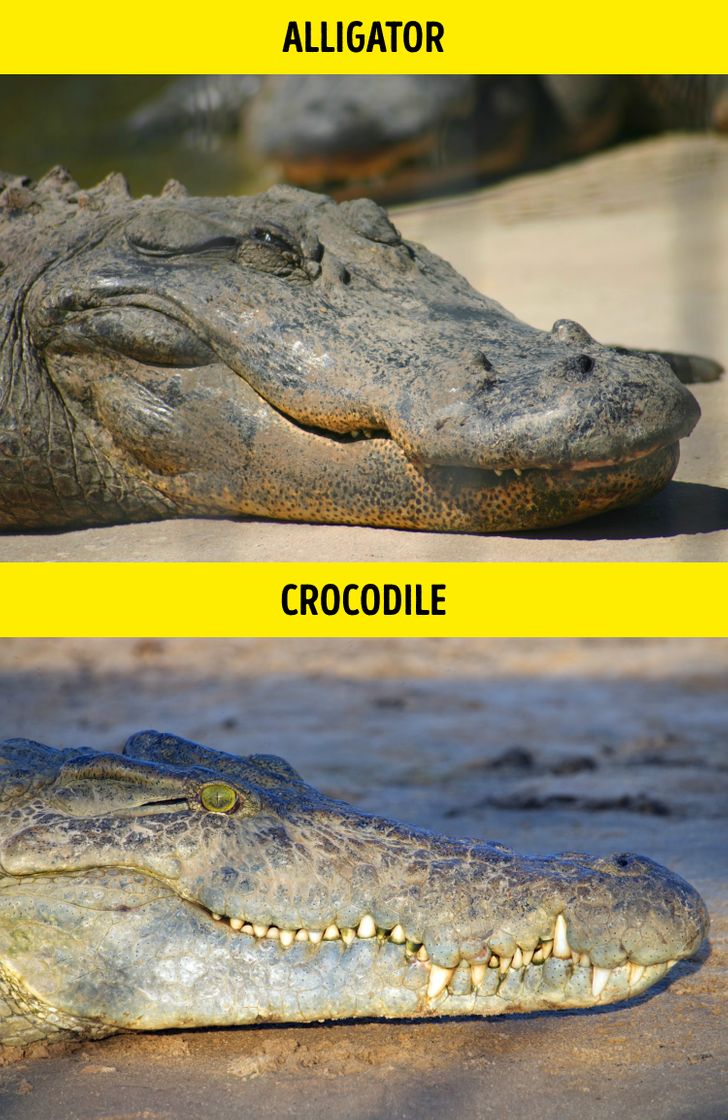
You can easily identify these 2 by the shape of their snouts: crocodiles have prominent, elongated V-shaped faces while alligators have shorter, wider U-shaped ones. Also, consider the teeth: crocodiles display their trademark toothy “grin” with every fourth tooth visible. Conversely, the alligator’s upper jaw is broader than the lower one, so its teeth aren’t visible for the most part.
3. Wasp vs hornet
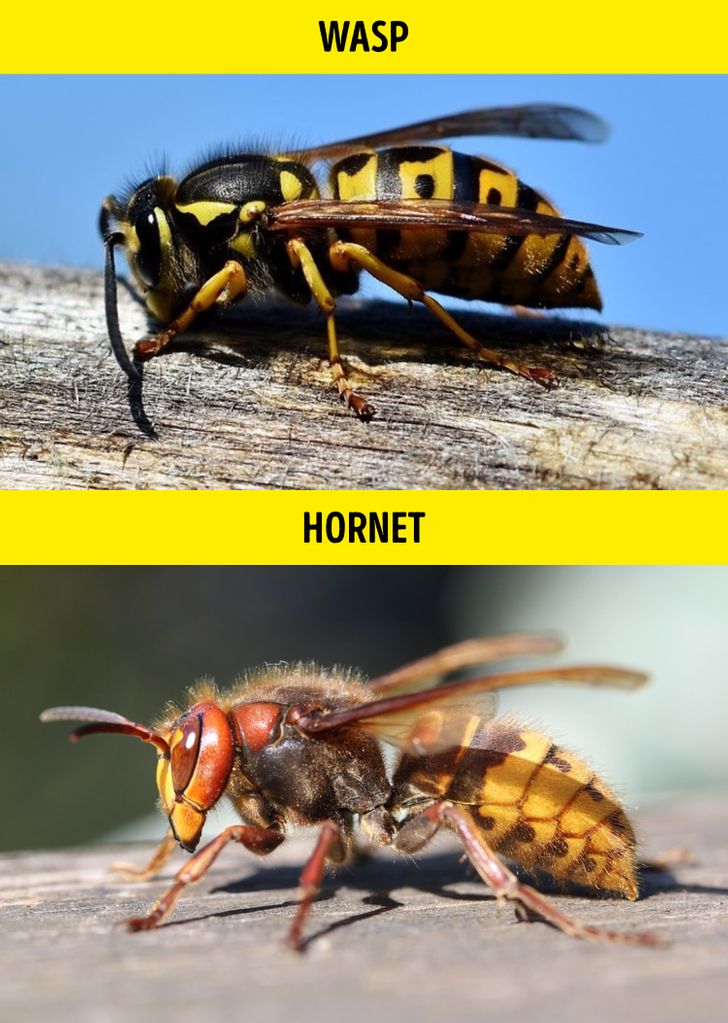
Both insects are menacing, that’s for sure. Hornets are larger and boast orange and black coloring, resembling spots rather than stripes, while wasps are more brightly colored and have yellow and black rings. You’re better off avoiding both.
4. Seal vs sea lion
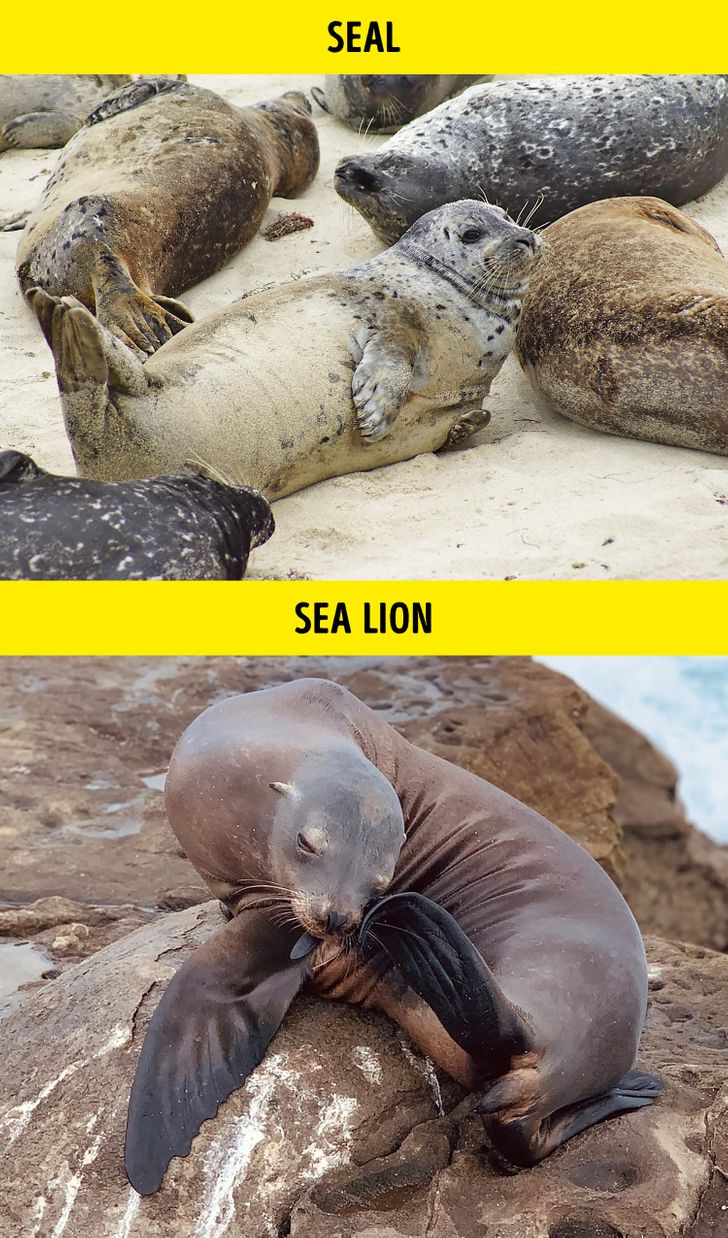
You’ve most likely met seals as cute plushy animals and sea lions as circus acrobats. Seals are covered with fur and have tiny front flippers which prevent them from walking, forcing them to wiggle on their bellies. Sea lions have smooth skin and vast flippers that they use to move on the ground.
5. Turtle vs tortoise
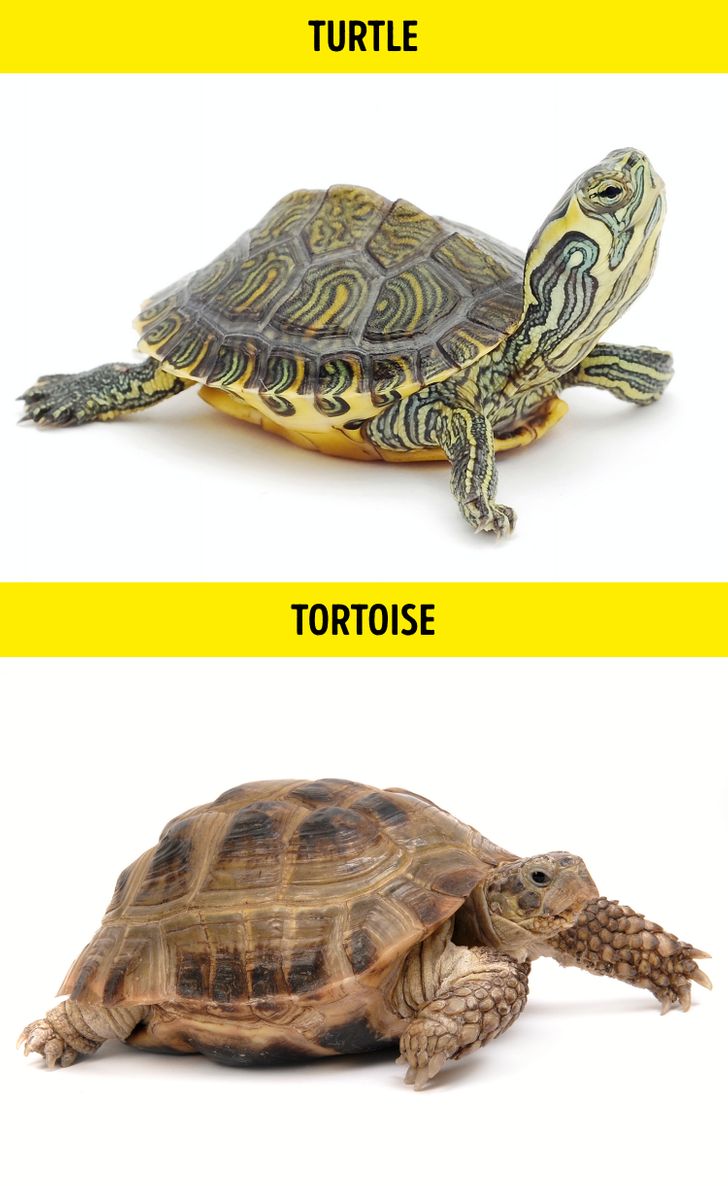
These 2 are both mobile (but very slow at that) and boast 4 legs. But the “turtle rock” is aquatic and has markings that resemble stains and circles on the water to better hide in the ponds. The “tortoise rock” is a land animal and spends most of its time on the ground — that is, as a literal rock.
6. Raven vs crow vs rook vs jackdaw
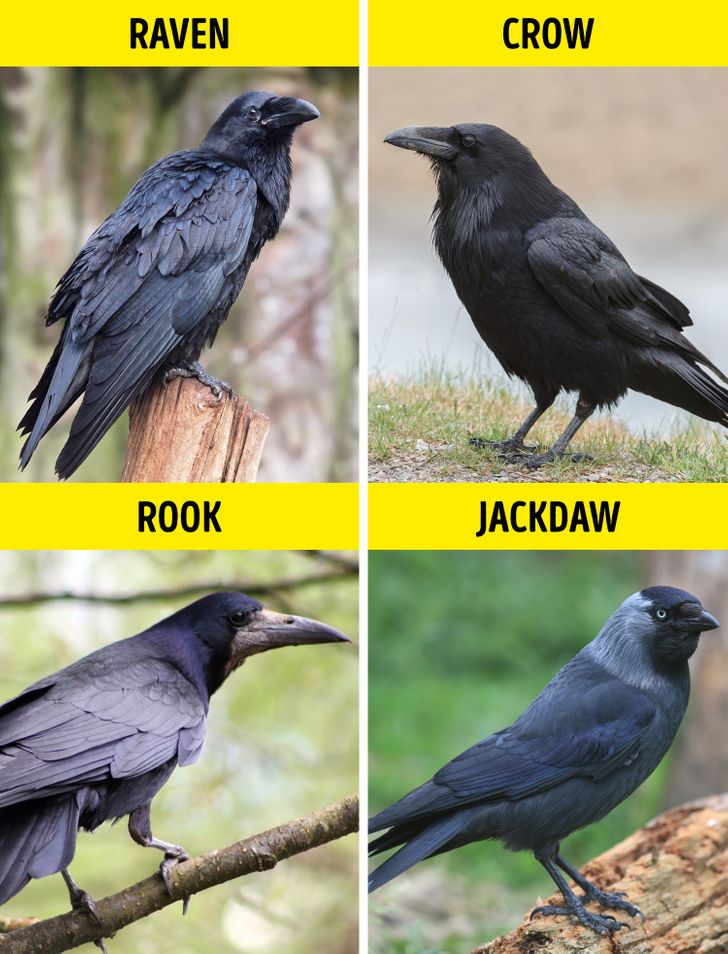
Most corvids look fairly similar (excluding jays who are like a theatre kid in a goth family). Ravens are the loftiest and most fashionable thanks to their “beard” of throat feathers. Crows and rooks are of the same size, but rooks have a distinct grey beak and fancy feather “pants” on their legs. Jackdaws are the goofiest-looking thanks to their very short beaks and a round heads with black caps.
7. Donkey vs mule
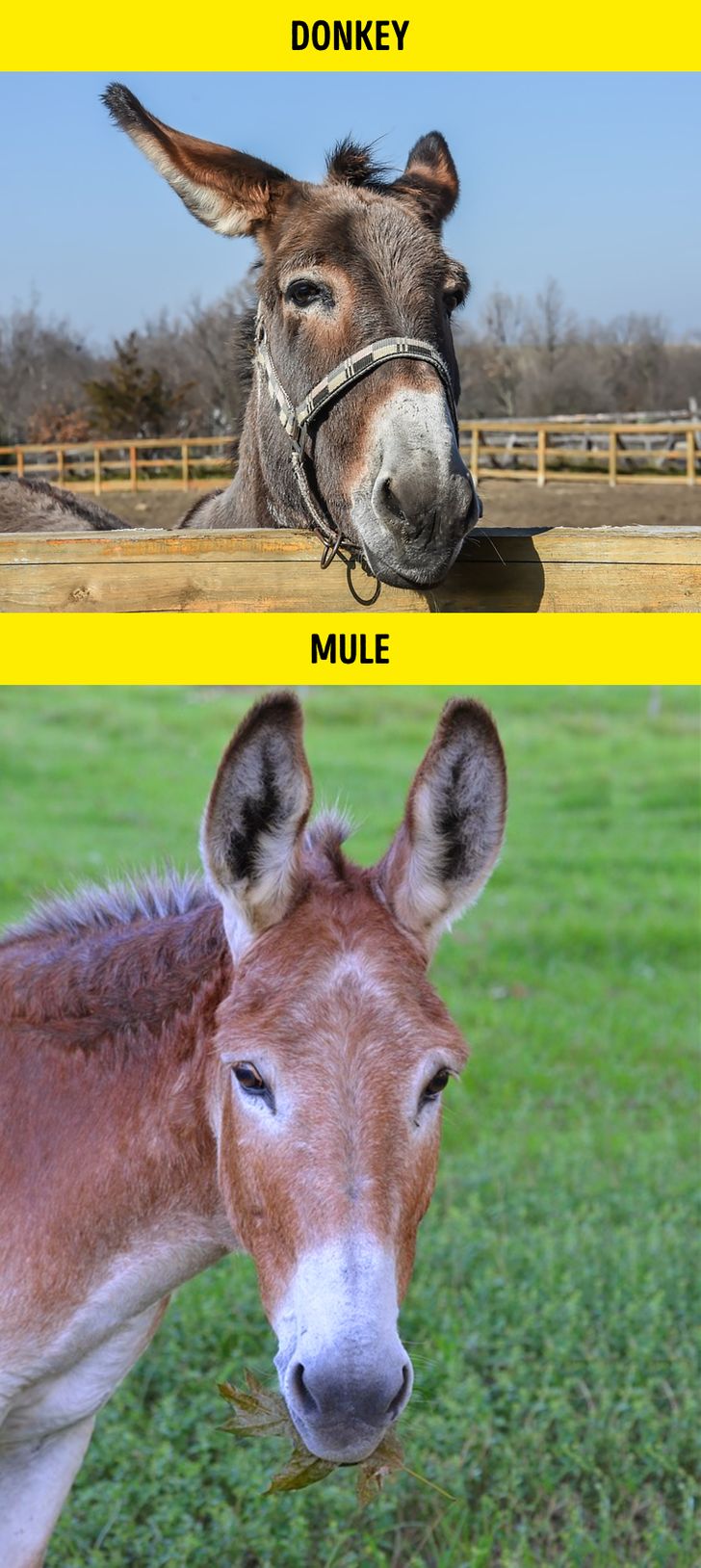
This one is tricky for a simple reason: while the donkey is its own species, a mule is a hybrid of donkey and horse. Funnily enough, it looks exactly like what you’d think these 2 animals would look like: an elegant head of a horse with ridiculously oversized donkey ears.
8. Hare vs rabbit
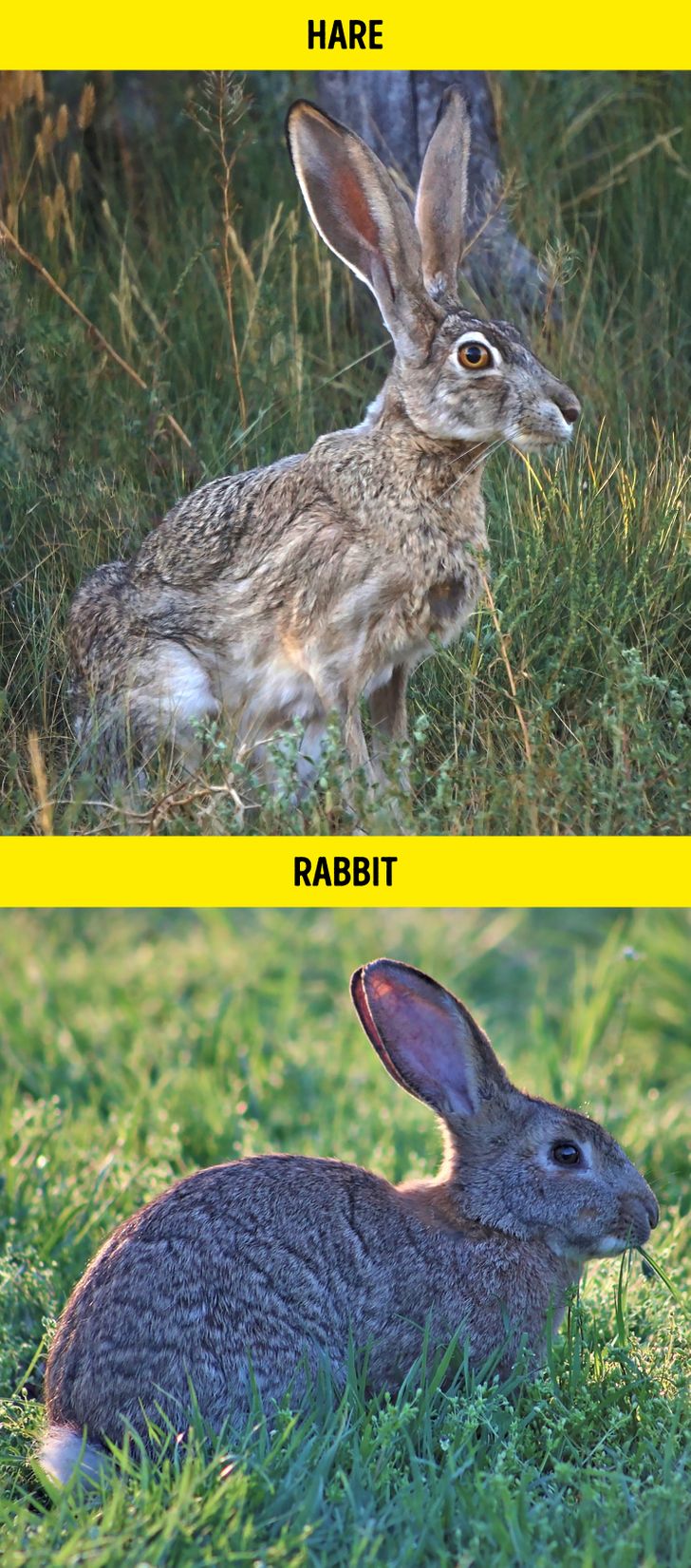
If you want a cuddly little pet, a rabbit is your best bet, but a hare definitely is not. Hares are larger and faster and have longer legs and ears. Rabbits are smaller, fluffier, and overall “cuter.” They even eat different food: rabbits prefer vegetables (like carrots) and soft grass while hares prefer bark and twigs. Rabbits are social animals while hares tend to be solitary. It’s no wonder rabbits are easily domesticated while hares mostly stay feral.
9. Moth vs butterfly
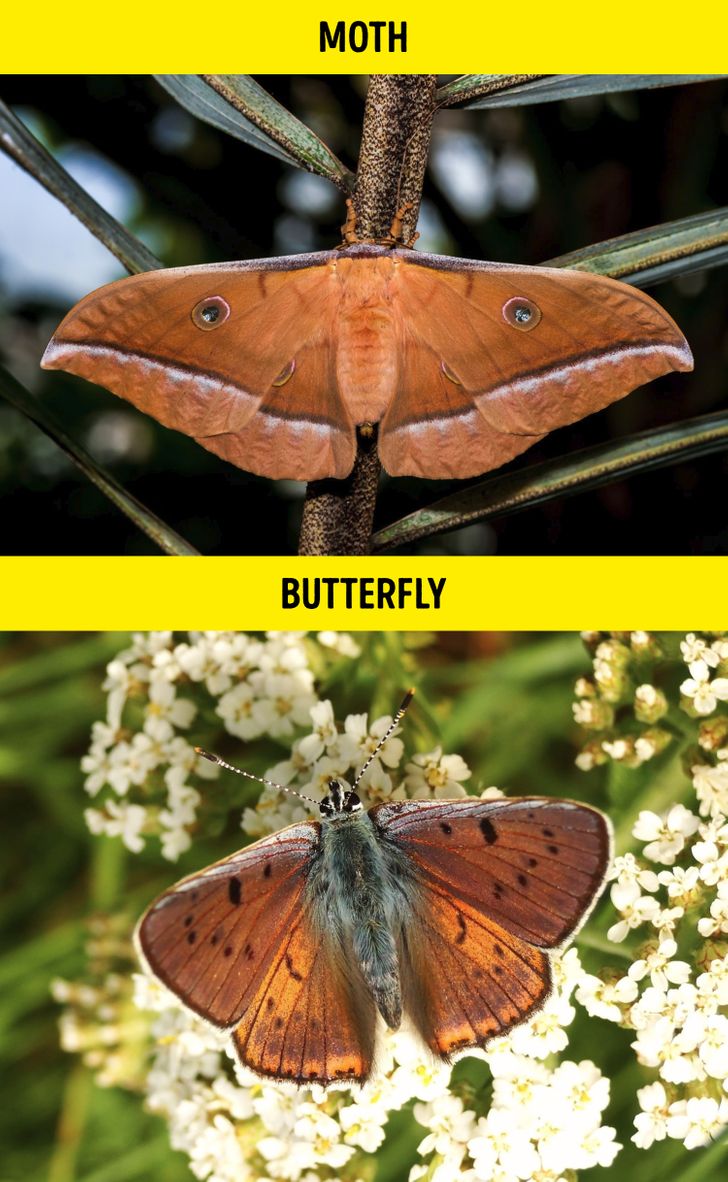
Moths have tent-like wings while butterflies flap their wings vertically. Moths usually rest with their wings open, while butterflies rest with their wings closed. Their antennas also differ: butterflies’ are long and thin and moths’ are short and feathery. Butterflies are strictly diurnal, while moths are mostly nocturnal.
10. Dolphin vs porpoise
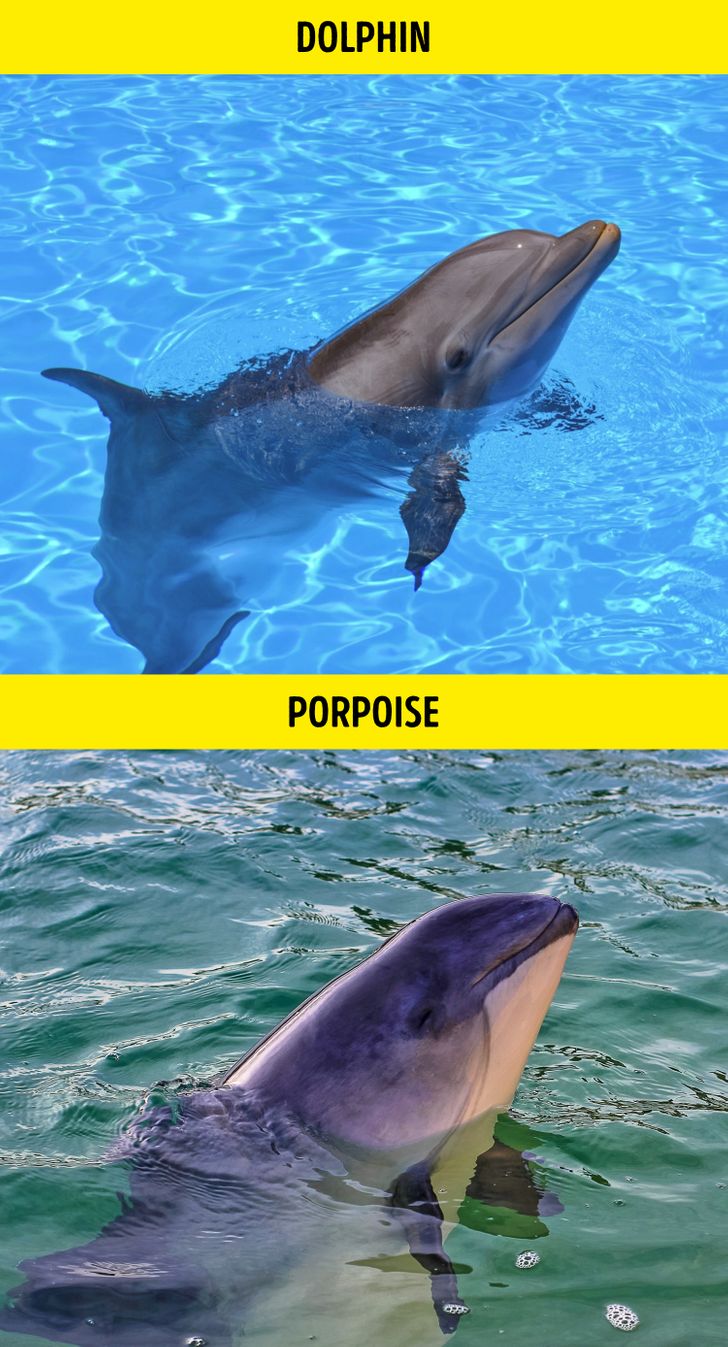
The difference between dolphins and porpoises comes down to their snouts, fins, and figures. Dolphins have long “beaks,” slender bodies, and curved dorsal fins. Porpoises have more flat, sloping faces, smaller flippers, and shorter triangular dorsal fins.
11. Weasel vs stoat
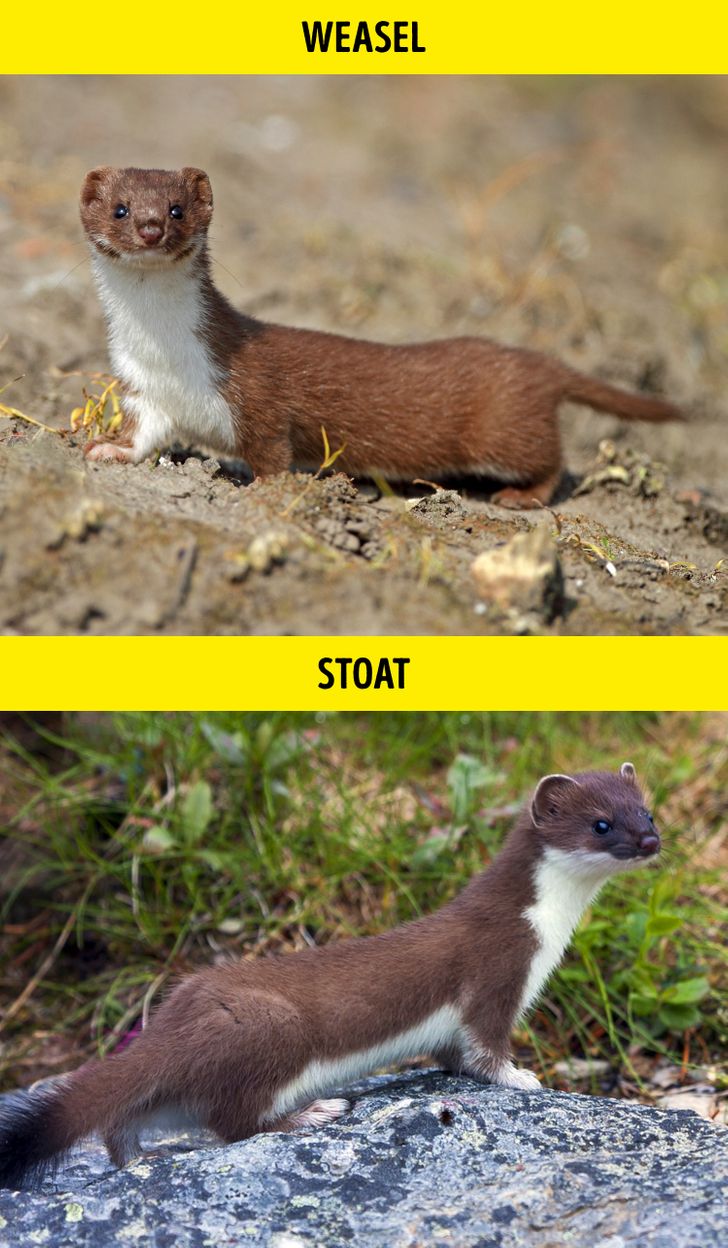
These 2 animals are close relatives. Stoats are bigger and have long tails with fuzzy black tips, while weasels’ tails are short and of the same color as the rest of the body. Stoats move in a bouncing gait with an arched back which looks hilarious, and weasels keep closer to the ground. Stoats also turn white in winter.
12. Eagle vs hawk vs falcon
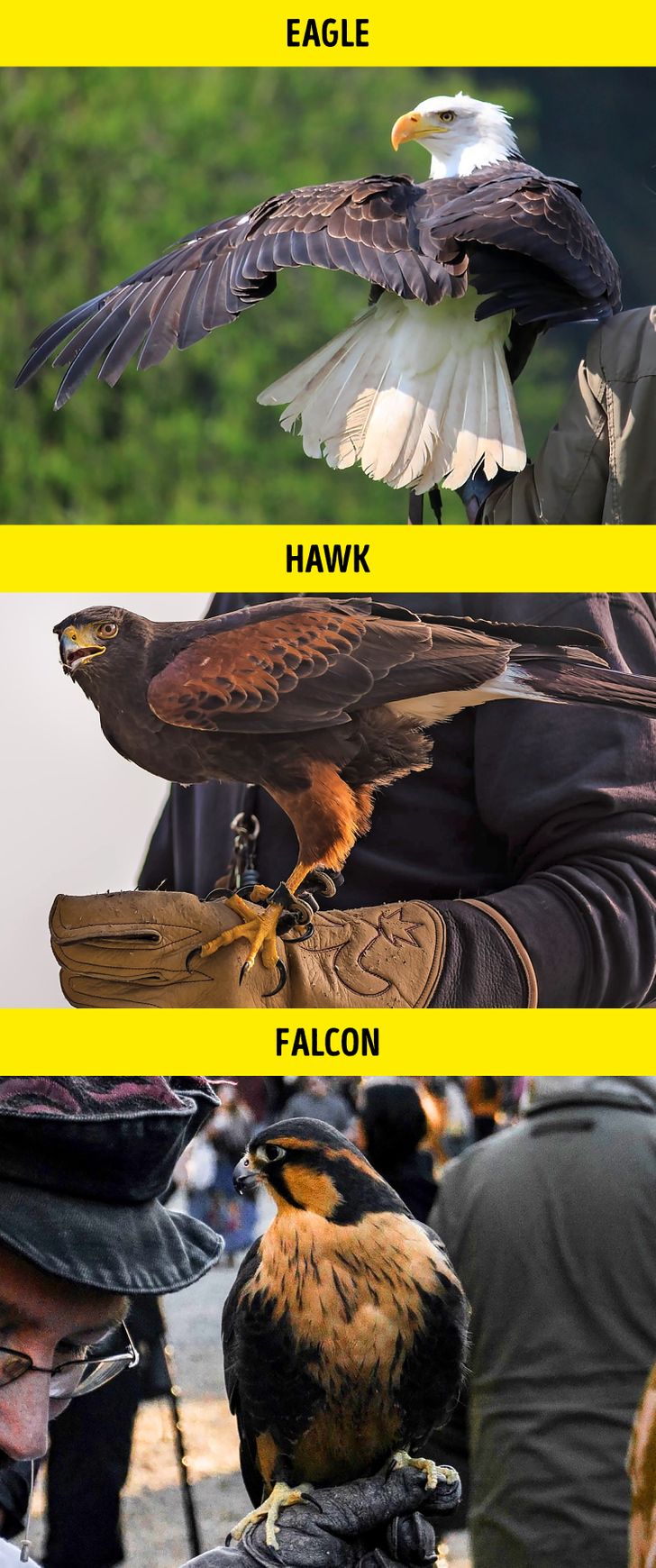
Eagles are gigantic, powerful birds who prefer to live in open spaces like cliffs and mountains. Hawks are a little smaller and more nimble in the air, capable of maneuvering in more closed areas. Falcons are the smallest and fastest of the 3 and differentiate the most visually: they have larger eyes and shorter beaks.
13. Mouse vs rat
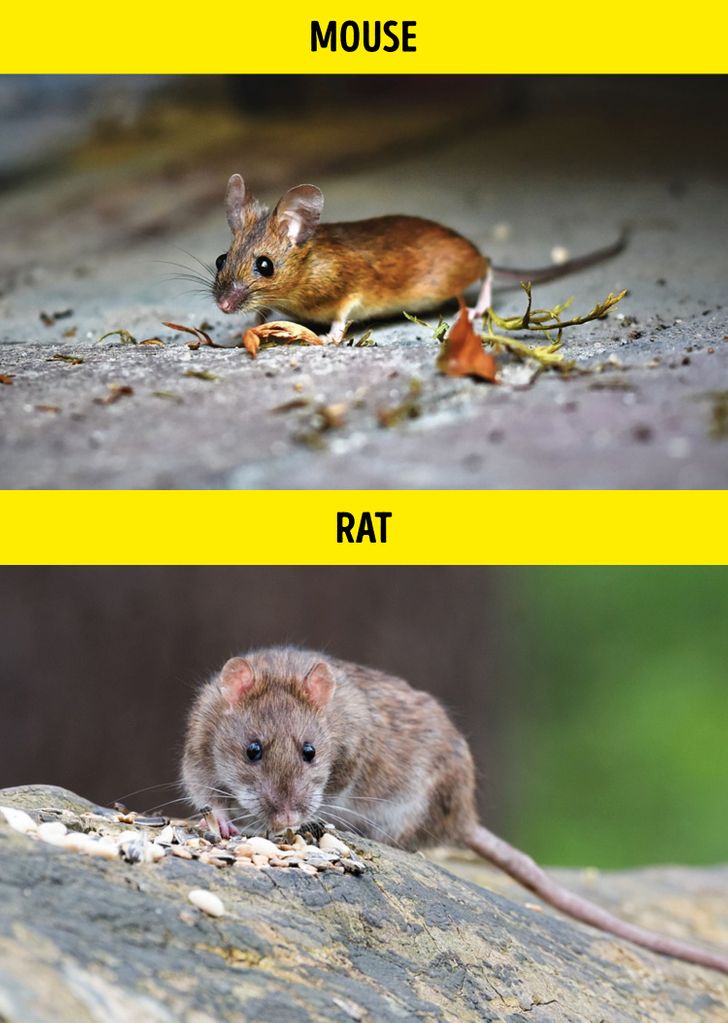
The 2 most famous (or infamous) rodents can be easily distinguished by 3 things: their size, tail, and ears. Mice are diminutive, even compared to young rats; they have thin long tails covered with fur while rats’ tails are thick and hairless. Mice have ears that are bigger in proportion to their bodies and are round and floppy with a tiny, triangular face. Rats’ faces are more prominent and blunt.
14. Seagull vs albatross
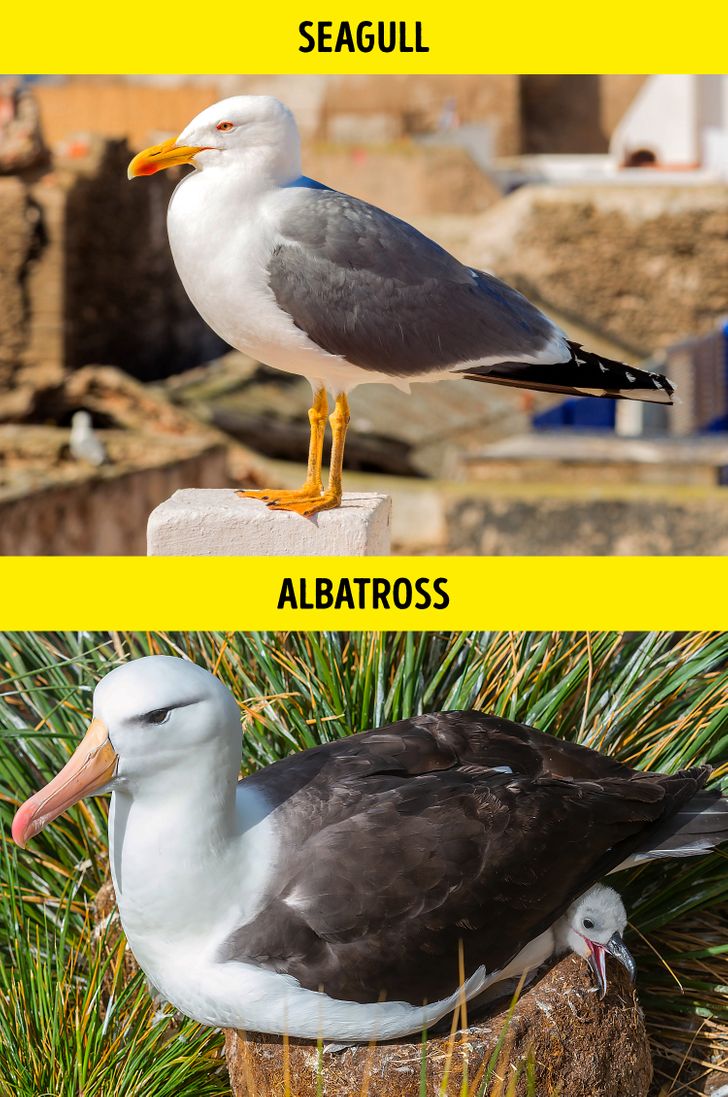
Gulls often live near water, be it the sea or ponds, and are rather acrobatic while diving and fish-catching, but aren’t fans of long voyages, unlike albatrosses. Albatrosses are portly birds who live in constant flight over the sea. They even have unique nostrils that allow them to remove salt from water and food.
15. Wolverine vs honey badger
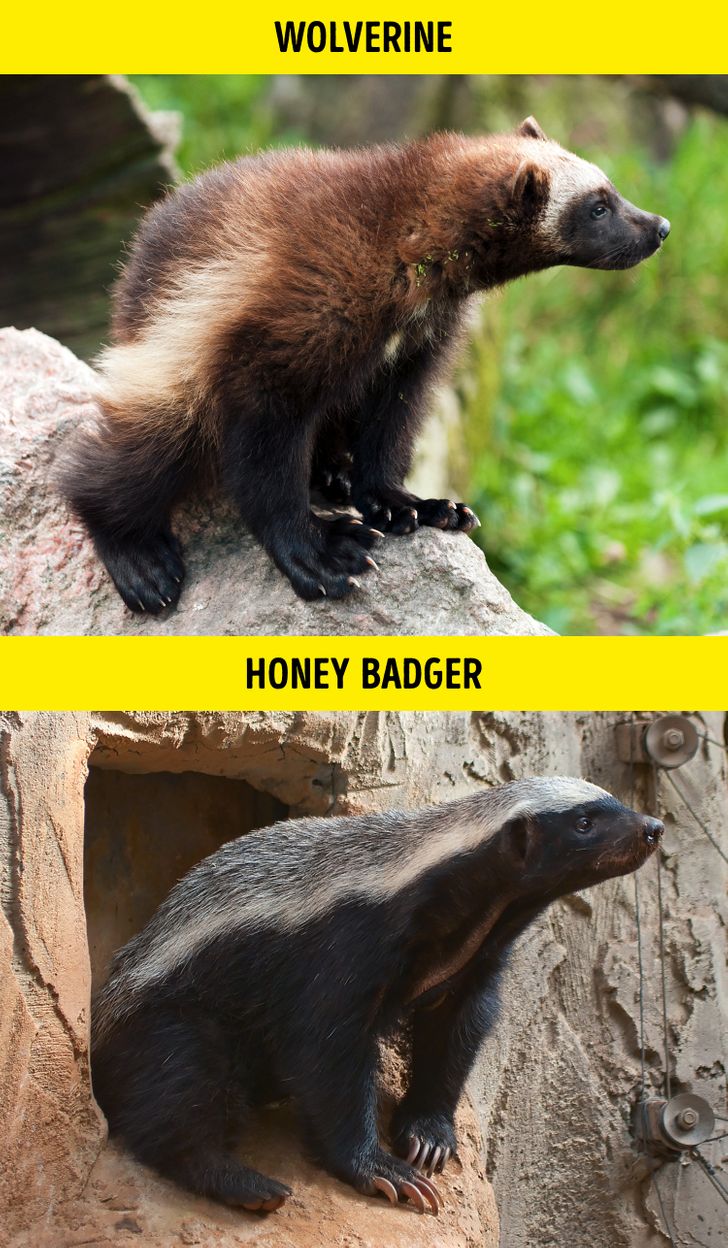
Despite living in different climate zones — the honey badger that lives in Africa and the wolverine that resides in the northern forests — both belong to the Mustelidae family. Wolverines are taller with longer legs and noticeable ears and have brown fur with yellow rings. Honey badgers keep closer to the ground and have black bodies with a white “cape” on their backs.
16. Wolf vs coyote vs jackal
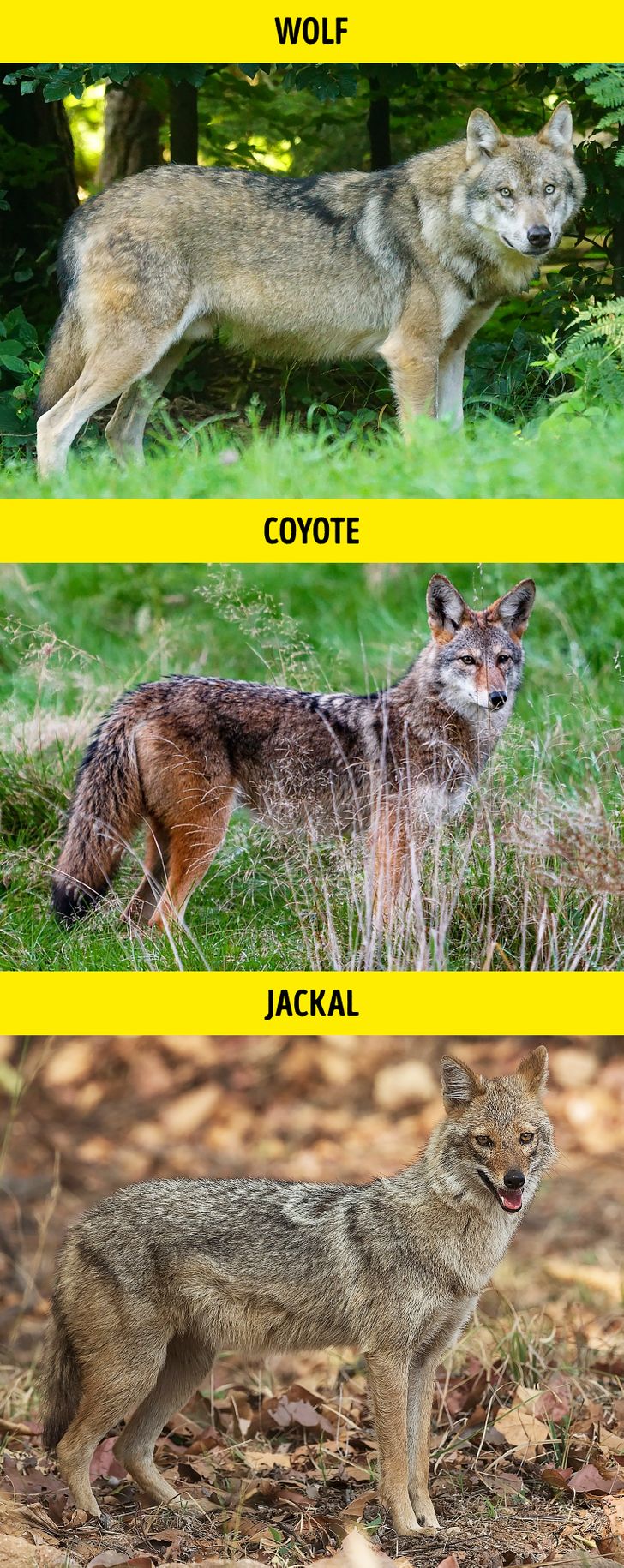
These 3 are “good boys and girls” that parade all over the globe. Jackals live in Africa, Asia, and India; coyotes live in Northern America; and wolves live all over the place. Wolves are large, sturdy animals, while coyotes and jackals possess a more lean and fragile frame.
Coyotes are recognizable for the red fur on their faces and ears while jackals have a more yellow-colored coat. Additionally, jackals are noticeably less fluffy because they don’t have to endure the harshness of winter.
Funny bonus: Wolverine vs the honey badger

What kinds of animals have ever confused you? If you know more examples, share them in the comments!
Preview photo credit shutterstock.com, shutterstock.com
Boy’s Innocent Promise Leads to Shocking Discovery in Old Lady’s Potted Plant – You Won’t Believe What It Was
When Daniel saw his older neighbor arguing with her son about her plants, he decided to help her. He offered to water her garden while she moved. Later, he discovered a note hidden in the soil that changed everything in an unexpected way.
“I can’t believe you would ask that of me! I can’t come here every day to water your plants! If you gave me the house, I would do it!” Daniel heard someone shouting as he stopped his bike in front of a pretty little house with a lovely garden. He knew Mrs. Carrino lived there, but he had never spoken to her and didn’t know who was yelling.
Suddenly, he saw a man leave the house, still shouting, with the older woman following behind. “Arnold, I asked you to help me, but all you care about is getting this house! Are you crazy? Do you want me to die so you can have my house?” she exclaimed.

Daniel’s eyebrows raised in surprise, and he thought about leaving, but he couldn’t move.
Then, he heard a loud crash of metal. “What the—” he said to himself.
“You’re being dramatic, Mom! This house will be mine anyway. I can’t believe you’re acting like this when I’m trying to help you move!” Arnold shouted.
“Leave right now if you’re going to act like that!” Mrs. Carrino replied. Arnold angrily stomped to his car and drove off. They were so caught up in their argument that they didn’t even notice Daniel standing there with his bike.
Finally, Mrs. Carrino looked over and noticed him. “Oh, dear. What are you doing here? Do I know you?” she asked.

“I live two houses down the street. I’m Daniel, Caroline’s son,” he said, pointing back to his house. “I’m sorry, but I was biking around and heard the yelling. Are you alright, Mrs. Carrino?”
“Oh, I remember you now! It’s nice that you know my name. Don’t worry about it. It was just my son being difficult,” she explained.
“Why is he acting like that?”
“Well… I’m moving to a nursing home, and I asked him to help me. But he only came here to ask if I could give him the house. He wants to move in, but I know he’ll just sell it. He doesn’t value it like I do. I worked hard for this place, and as long as I’m alive, I won’t sell it,” Mrs. Carrino said. “Then he threw a fit when I asked him to water my plants. I guess you saw the rest of the fight.”

“I can do that,” Daniel said, shrugging his shoulders.
“Do what?”
“Water your plants.”
“I can’t pay you, dear,” Mrs. Carrino replied, looking sorry.
“I know. But I live so close. It’s not a problem,” Daniel insisted, making her smile brightly.
A few days later, Mrs. Carrino moved to a nursing home nearby, and Daniel kept his promise. He visited her home almost every day to water her plants and was happy to help. Before long, he started to love gardening and would visit Mrs. Carrino to ask about adding some new plants.
Dropping the shovel, Daniel used his hands to dig up a mason jar with a metal lid and found a note inside.
“Dear Daniel! Thank you for your help. This house is now yours! Go inside and find all the paperwork. You and your family can move in whenever you want!”
Daniel couldn’t believe his eyes. He rushed inside, using the key Mrs. Carrino had left him. On the kitchen counter, he saw the title to the house. Although he didn’t understand most of it, he saw his name at the bottom.
Still in shock, he called Mrs. Carrino, who confirmed everything. “You’ll need to sign it to complete the transfer. But I wanted you to find the note first!” she said.
His mother couldn’t believe it either. They could move into the house and stop paying rent. There was no mortgage, which would help their family a lot. They were so grateful for Mrs. Carrino’s gift that his mother and siblings started visiting her often, thinking of her as a grandmother.
But during their move, Daniel discovered something even more surprising. In Mrs. Carrino’s old room, he found another note. It was similar to the first one but said “Arnold.”
It turned out that Mrs. Carrino had originally planned to give her son the house if he helped her with her plants. However, after his rude behavior, she changed her mind and decided to give the house to Daniel instead.
This unexpected gift came just for being kind and helpful. It was a lesson Daniel would never forget.



Leave a Reply